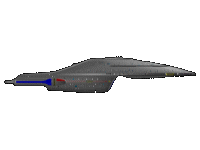

The Intrepid design was issued in 2358 to replace the falling production numbers of older starships such as the Ambassador and Excelsior class ships. It called for a vessel to be around 360 meters long with a volume of about 15% of a Galaxy class ship.Although the limited size meant that the vessel would have much lower overall capabilities than the Galaxy class, this was to be in some part offset by the use of the latest technology. The ships computer system would be the most advanced model in service; the increased automation this afforded combined with a new generation of sensor equipment would allow the Intrepid class almost 30% of the scanning and analysis capabilities of a Galaxy class starship. A top cruise speed some three times that of the Galaxy would further enhance the vessels exploration capabilities.
Hosting diplomatic functions would be difficult because a Intrepid would simply not have enough room to do this.Therefore its diplomatic capabilities are limited to small events.The Intrepid's combat role was also somewhat limited by her size; unable to carry large numbers of torpedoes or high power phaser banks, Starfleet settled on a scouting and support mission for the ship. Fitted out with Type VIII phaser arrays and single fire torpedo tubes, the Intrepid would be capable of engaging vessels the size of a Bird of Prey one-on-one. Her high speed and manoeuvrability combined with the advanced sensor system would also make her a perfect platform to conduct long range reconnaissance missions ahead of fleet operations. Within a major fleet battle the Intrepid would also act in support of larger ships, harrying enemy fleet units and drawing fire away from larger Federation ships.
Development of the Intrepid class went smoothly until a major problem arose in 2370 with the discovery that the energy emissions of standard warp drives caused considerable cumulative damage to the structure of subspace. Starfleet called for all designs then in progress to be modified to eliminate this effect, and it was decided to use the Intrepid class as a test bed for this technology. After some experimentation it was found that the effect could be avoided by using a warp field with a much elongated Z-axis, combined with complex warp field modulation and the utilization of new materials during the manufacture of warp coils. This has led to the ships saucer section having the forward ellipse now becoming common on Federation designs. The new warp field configuration did lead to a 15% reduction in the speed of the Intrepid class across all flight regimes, bringing the top cruise speed down from Warp 9.99 to Warp 9.975.
The Intrepid building program suffered a serious setback when the USS Voyager, second in the class, was apparently lost on her first mission. Building was suspended on the class while the designs were subjected to intense scrutiny; after a year without results the Intrepid project was resumed. It was subsequently discovered that Voyager was in fact displaced to the other side of the Galaxy by an alien technology. After struggling to return home for nearly ten years, Voyager finally made it back to Earth via a Borg transwarp conduit.
One feature unique to the Intrepid class among Federation starships of this size is the ability to land on a planetary surface. This feature has been incorporated after several incidents in which transporters and shuttle craft have been unable to operate through exotic environmental conditions during evacuations or other surface related operations.
Type- Light Explorer
Units- USS Intrepid, NCC 74705 USS Bellerophon, NCC 74656 USS Voyager, plus 47 others. 15 were lost in the Dominion war,35 left in service. The USS Voyager was classified as lost for several years,but is now known to be making its way back to the Alpha Quadrent from the Delta Quadrent.
Date of Commission- 2370
Dimensions- 343.56 meters X 66.78 meters - 15 decks
Mass- 700,000 metric tons
Crew Compliment- 150
Armaments- 13 Type 8 phasers arrays -total output of 10,000 terawatts , 4 standard photon/quantum torpedo tubes + 38 torpedoes
Defence Systems- Shield system-total capacity of 729,000 terajoules , duranium/tritanium single hull , standard level structual intregrity field
Warp Speed Capability- Normal cruise: Warp factor 8 , Maximum Cruise: Warp factor 9.975
Strength Indices(1000 is equal to a Galaxy class ship)- Beam firepower: 200 , Torpedo firepower: 500 , Weapon range and accuracy: 440 , Shield strengh: 270 , Hull Armor: 50 , Speed: 3526 , Combat Manuverability: 7500
Overall Strengh Index(out of 1000)- 555
Expected Hull Life- 80 years
Refit cycles-Minor: 1 year , Standard: 5 years , Major: 20 years
